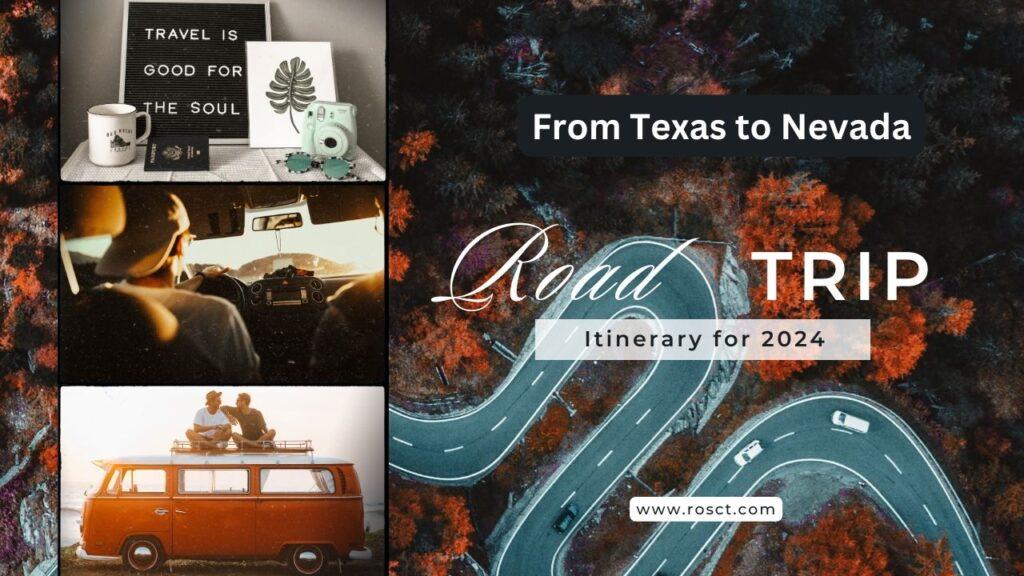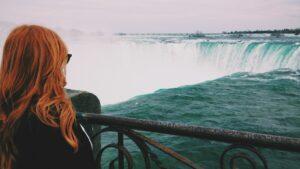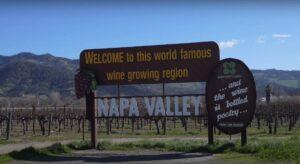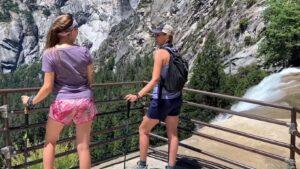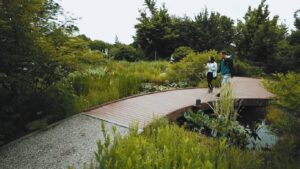If you are planning a road trip adventure in 2024, you should check out our guide for the best road trip itinerary from Texas to Nevada. This is a trip that will let you experience the diversity and beauty of two amazing states in the US. You will discover attractions such as cities, culture, cuisine, history, and nature. We will show you how to travel from Texas to Nevada by car, including the best routes, stops, distances, durations, and tips. Don’t miss this opportunity to explore some of the most exciting and scenic places in the country.
Texas: The Lone Star State
Texas is the second-largest and second-most populous state in the US. It is also one of the most culturally and geographically diverse states, with influences from Native American, Spanish, Mexican, German, African American, and Asian cultures.
Texas is known for its cowboy culture, barbecue, music, sports, and oil industry. It also has some of the most beautiful and unique natural landscapes in the country, such as deserts, mountains, plains, forests, and coastlines.
Places to Visit in Texas:
Some places in Texas are discussed here. Those are Austin, San Antonio, Houston, Dallas, Big Bend National Park, and Palo Duro Canyon.
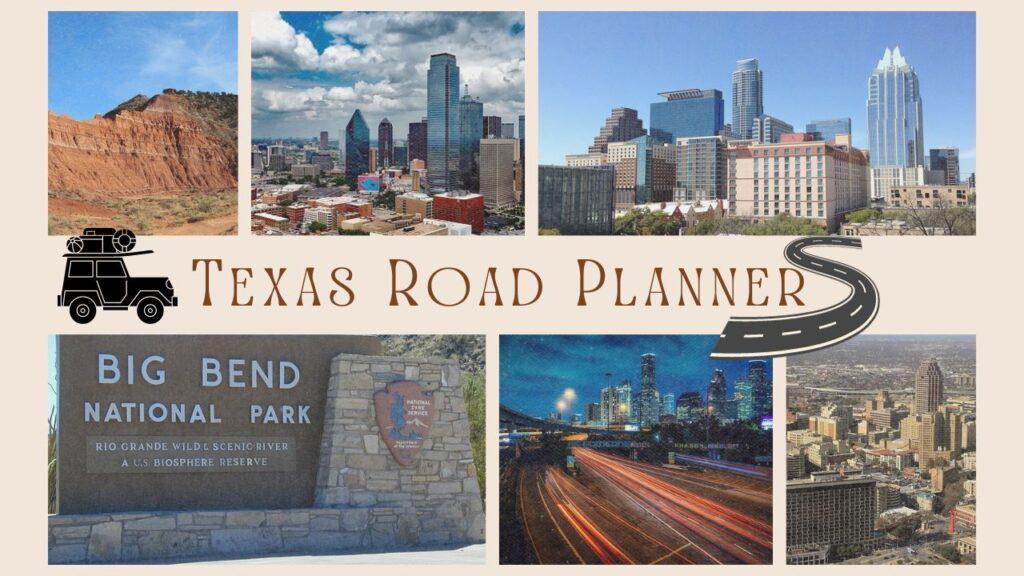
Austin: This is the capital and the most progressive city of Texas. It is famous for its live music scene, especially in genres like country, blues, and rock. It is also home to the University of Texas, which has a vibrant campus life and a prestigious reputation. You can enjoy the city’s culture, nightlife, food trucks, and festivals. You can also visit the Texas State Capitol, the LBJ Presidential Library, and Lady Bird Lake.
San Antonio: This is the second-largest city and one of the most historic cities in Texas. It is best known for its Spanish colonial heritage, especially the Alamo, where a famous battle took place in 1836. You can also explore the River Walk, a network of walkways along the San Antonio River that offers shops, restaurants, bars, and museums. You can also visit the San Antonio Missions National Historical Park, which preserves four 18th-century missions.
Houston: This is the largest and most populous city in Texas. It is also one of the most diverse and cosmopolitan cities in the US. It is a global hub for energy, aerospace, medicine, and culture. You can visit the Space Center Houston, where you can learn about NASA’s missions and see rockets, spacecraft, and exhibits. You can also visit the Houston Museum District, which has 19 museums, including the Museum of Fine Arts, the Houston Zoo, and the Children’s Museum.
Dallas: This is the third-largest city and one of the most modern and dynamic cities in Texas. It is a center for business, finance, technology, and entertainment. You can visit the Dallas Arts District, which has some of the finest cultural institutions in the country, such as the Dallas Museum of Art, the Nasher Sculpture Center, and the Winspear Opera House. You can also visit the Sixth Floor Museum at Dealey Plaza, which commemorates the assassination of President John F. Kennedy in 1963.
Big Bend National Park: This is one of the most spectacular and remote national parks in the US. It covers over 800,000 acres of land along the Rio Grande River, which forms the border between Texas and Mexico. You can see diverse landscapes, such as mountains, deserts, canyons, and rivers. You can also see diverse wildlife, such as bears, coyotes, bobcats, and birds. Enjoy hiking, camping, rafting, and stargazing.
Palo Duro Canyon: This is the second-largest canyon in the US after the Grand Canyon. It stretches for 120 miles and reaches depths of up to 800 feet. It was formed by erosion from water and wind over millions of years. You can see colorful rock formations, such as hoodoos, pinnacles, and mesas. You can also see ancient fossils and petroglyphs. Enjoy hiking, biking, horseback riding, and zip-lining.
Nevada: The Silver State
Nevada is the seventh-largest and the ninth-least populous state in the US. It is also one of the most arid and mountainous states, with most of its land being part of the Great Basin. Nevada is known for its entertainment, gambling, mining, and ranching industries. It also has some of the most fascinating and diverse natural attractions, such as lakes, rivers, deserts, and valleys.
Places to Visit in Nevada:
There are many places to explore but we will provide the details of some of them. Those are Las Vegas, Reno, Lake Tahoe, Hoover Dam, and Valley of Fire State Park.
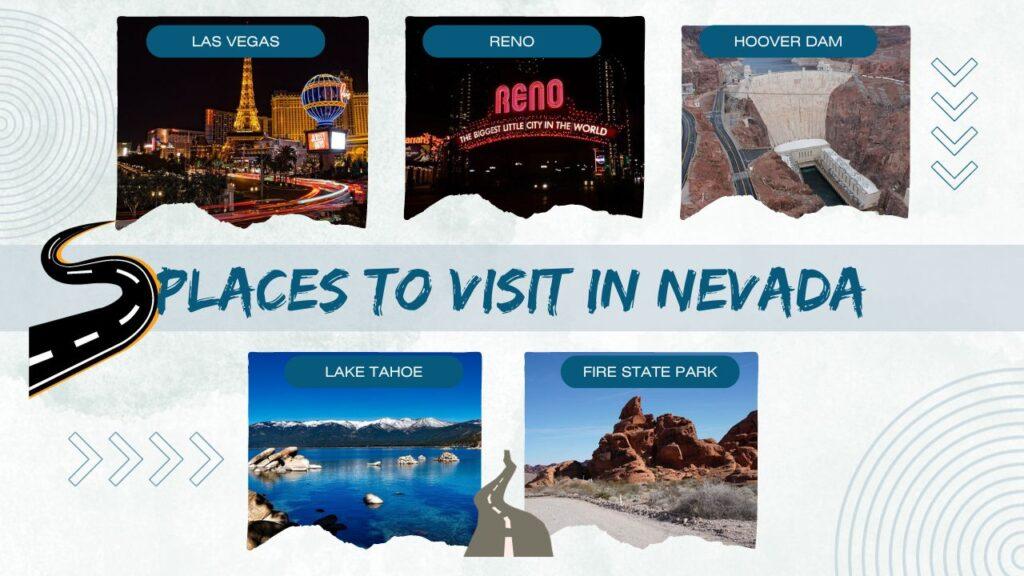
Las Vegas: Las Vegas is Nevada’s biggest and most famous city. It is a world-famous tourist destination for its casinos, hotels, shows, nightlife, and shopping. You can visit the Strip, which has iconic and luxurious resorts like Bellagio, Caesars Palace, MGM Grand, and Venetian. You can also visit Downtown Las Vegas, which has historic and cultural attractions like the Fremont Street Experience, the Mob Museum, and the Neon Museum.
Reno: Reno is Nevada’s second-largest and oldest city. It is also called “The Biggest Little City in the World“. It is a center for arts, culture, and outdoor recreation. You can visit the Riverwalk District, which has restaurants, bars, galleries, and museums along the Truckee River. Visit the Midtown District, which has local shops, cafes, and murals in a trendy and eclectic neighborhood. You can also enjoy activities such as skiing, hiking, biking, and rafting in the nearby Sierra Nevada mountains.
Lake Tahoe: This is one of the largest and deepest alpine lakes in North America. It is also one of the most beautiful and pristine lakes in the world. It is located on the border between Nevada and California, and it is surrounded by majestic mountains and forests. You can enjoy the lake’s clear blue water and sandy beaches, as well as its scenic views and wildlife. Enjoy activities such as boating, fishing, swimming, kayaking, and paddle boarding. You can also visit some of the charming towns and resorts around the lake, such as Incline Village, South Lake Tahoe, and Stateline.
Hoover Dam: This is one of the most impressive engineering feats in history. It is a concrete arch-gravity dam that spans the Colorado River between Nevada and Arizona. Hoover Dam was built during the Great Depression to provide hydroelectric power, flood control, and water supply to the region. It is also a National Historic Landmark and a popular tourist attraction. You can tour the dam, see its generators, and learn about its history and construction. You can also see the Lake Mead National Recreation Area, which is the largest man-made reservoir in the US.
Valley of Fire State Park: This is Nevada’s oldest and largest state park. It covers over 40,000 acres of land that features stunning red sandstone formations, canyons, arches, and petroglyphs. Valley of Fire State Park was named after its fiery appearance when the sun hits its rocks. It is also a haven for wildlife, such as bighorn sheep, coyotes, lizards, and birds. Hike through some of the park’s trails, such as Mouse’s Tank, Fire Wave, and White Domes. Also, camp at some of the park’s sites, such as Atlatl Rock, Arch Rock, and Seven Sisters.
Road Trip Itinerary for 2024: From Texas to Nevada
Now that you have an idea of what to see and do in Texas and Nevada, you need to plan your road trip itinerary. There are many possible ways to travel from Texas to Nevada by car, but we will suggest one of the best routes, stops, distances, durations, and tips. You can also modify this itinerary based on your preferences and budget.
Day 1: Austin to San Antonio (80 miles, 1.5 hours)
Start your road trip in Austin, the capital and the most progressive city of Texas. You can spend some time exploring the city’s culture, nightlife, food trucks, and festivals.
You can also visit the Texas State Capitol, the LBJ Presidential Library, and Lady Bird Lake. Then, drive south to San Antonio, the second-largest and one of the most historic cities in Texas.
You can visit the Alamo, where a famous battle took place in 1836. You can also explore the River Walk, a network of walkways along the San Antonio River that offers shops, restaurants, bars, and museums.
Day 2: San Antonio to Houston (197 miles, 3 hours)
Continue your road trip east to Houston, the largest and most populous city in Texas. It is also one of the most diverse and cosmopolitan cities in the US. It is a global hub for energy, aerospace, medicine, and culture.
You can visit the Space Center Houston, where you can learn about NASA’s missions and see rockets, spacecraft, and exhibits.
You can also visit the Houston Museum District, which has 19 museums, including the Museum of Fine Arts, the Houston Zoo, and the Children’s Museum.
Day 3: Houston to Dallas (240 miles, 4 hours)
Drive north to Dallas, the third-largest and one of the most modern and dynamic cities in Texas. It is a center for business, finance, technology, and entertainment.
You can visit the Dallas Arts District, which has some of the finest cultural institutions in the country, such as the Dallas Museum of Art, the Nasher Sculpture Center, and the Winspear Opera House.
You can also visit the Sixth Floor Museum at Dealey Plaza, which commemorates the assassination of President John F. Kennedy in 1963.
Day 4: Dallas to Amarillo (364 miles, 5.5 hours)
Leave the city behind and head west to Amarillo, a city in the Texas Panhandle that is known for its cowboy culture and Route 66 heritage. You can visit some of the quirky attractions along the way, such as Cadillac Ranch, a public art installation that features 10 graffiti-covered Cadillacs buried nose-down in a field.
Also, visit Palo Duro Canyon State Park, which is the second-largest canyon in the US after the Grand Canyon. You can hike through some of the park’s trails, such as Mouse’s Tank, Fire Wave, and White Domes. You can also camp at some of the park’s sites, such as Atlatl Rock, Arch Rock, and Seven Sisters.
Day 5: Amarillo to Santa Fe (281 miles, 4 hours)
Cross the state border and enter New Mexico, a state that is rich in Native American and Hispanic culture and history. Drive north to Santa Fe, the capital and one of the oldest cities in the US. It is also one of the most artistic and scenic cities in the country.
You can visit some of the historic landmarks, such as the Santa Fe Plaza, the Palace of the Governors, and the Cathedral Basilica of St. Francis of Assisi. You can also visit some of the art galleries and museums, such as the Georgia O’Keeffe Museum, the Museum of Indian Arts and Culture, and the Museum of International Folk Art.
Day 6: Santa Fe to Albuquerque (64 miles, 1 hour)
Drive south to Albuquerque, the largest city and one of the most vibrant and diverse cities in New Mexico. It is also known for its hot-air balloon festival, which is held every October.
You can visit some of the attractions in the city, such as the Old Town, the Sandia Peak Tramway, and the Indian Pueblo Cultural Center. You can also enjoy some of the local cuisine and craft beer.
Day 7: Albuquerque to Flagstaff (323 miles, 5 hours)
Continue your road trip west and enter Arizona, a state that is famous for its desert landscapes and natural wonders. Drive to Flagstaff, a city that is located near some of the most spectacular national parks in the US.
You can visit some of them, such as Grand Canyon National Park, which is one of The Seven Natural Wonders of the World.
Hike along the rim trails or down to the Colorado River. You can also visit some other national parks, such as Petrified Forest National Park, which has fossilized trees that are millions of years old, and Wupatki National Monument, which has ancient Native American ruins.
Day 8: Flagstaff to Las Vegas (250 miles, 4 hours)
Drive north to Las Vegas, the largest and most famous city in Nevada. It is also one of the most popular tourist destinations in the world. It is renowned for its casinos, hotels, shows, nightlife, and shopping.
You can visit the Strip, which is a four-mile stretch of Las Vegas Boulevard that features some of the most iconic and luxurious resorts, such as Bellagio, Caesars Palace, MGM Grand, and Venetian.
You can also visit Downtown Las Vegas, which is the historic and cultural center of the city, where you can see the Fremont Street Experience, the Mob Museum, and the Neon Museum.
Day 9: Las Vegas to Reno (439 miles, 7 hours)
Leave Las Vegas behind and head north to Reno, the second-largest city and one of the oldest cities in Nevada. It is also known as “The Biggest Little City in the World“.
It is a hub for arts, culture, and outdoor recreation. You can visit the Riverwalk District, which is a vibrant area along the Truckee River that offers restaurants, bars, galleries, and museums.
Also, visit the Midtown District, which is a trendy and eclectic neighborhood that features local shops, cafes, and murals. You can also enjoy activities such as skiing, hiking, biking, and rafting in the nearby Sierra Nevada mountains.
Day 10: Reno to Lake Tahoe (60 miles, 1 hour)
End your road trip at Lake Tahoe, one of the largest and deepest alpine lakes in North America. It is also one of the most beautiful and pristine lakes in the world.
It is located on the border between Nevada and California, and it is surrounded by majestic mountains and forests. You can enjoy the lake’s clear blue water and sandy beaches, as well as its scenic views and wildlife.
Also, enjoy activities such as boating, fishing, swimming, kayaking, and paddle boarding. Visit the charming towns and resorts around the lake, such as Incline Village, South Lake Tahoe, and Stateline.
To make the most of your road trip, follow this guide as your navigation system. Book your tickets, hotels, car rentals, and insurance ahead of time to avoid any hassle. Keep an eye on the weather, road, and travel situation. Most importantly, enjoy the ride and cherish every moment!
